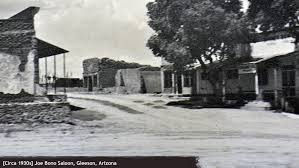Can't you just see the streets full of cowboys on horses coming in to town for a drink? They would tie up at the railing in front of the saloon on the right. Maybe that was just on Saturdays because during the week every one had to work.
Meet Joe Bono, son of the Bono Saloon owner, Joe Bono. He now runs the jail museum. He was only five years old in the saloon's heyday, living with his family in a back room of this building. Sadly not long ago, the roof caved in when it caught fire. As you can see, none of the adobe front was burned and it still stands today.
Joe's dad came from Italy when he was fourteen years old. He was almost immediately drafted into the Army and served his time in World War I before ending up in Gleeson. Joe has pictures of family hanging in the Jail Museum. When most of the town's people left, Joe Sr. went around gathering up stuff people left. He has quite the collection of shotguns, although most all are out of commission. They are held together with bolts and wire. After all, they didn't have money to buy anything new ... they just made the old work.
This building was originally built as the Gleeson outlet for Charles M. Renaud, a mercantile store owner, with stores in Courtland and Pearce as well. Over the years, it has been a gas station, private home, a hotel and a general curio stop, however most of its life was spent as a saloon.
As you walk around, you can see just how big it was, with living quarters in back. Joe remembers playing in back while his dad worked out front.
The building was still standing in 1982, but a fire in the back caused all this damage. Sadly, the State has taken over and says they will eventually tear it all down.
The little town of Gleeson boomed with the mining operations selling copper to the government. So much so that the warehouse, owned by B. A. Taylor was built to hold supplies that came in on the train spur built by the Arizona and Colorado Railroad through this notch in the mountain. This siding was built to supply the mines with machinery and the town with supplies. It went along the tracks (that red dirt area on the left) to a turntable where it was unloaded. The train was then loaded up with copper ore for a trip to the processing plant.
Supplies for the town were stored in this warehouse building basement in order to keep things from spoiling. This basement is where the fire started that burned down 28 buildings in 1912. They rebuilt the town and continued on until the mines finally played out in the 1930's.
Along with copper mining came a little gold and silver. The mines were prosperous enough to build a large school and a hospital. By this time, Shannon Mining Company bought out Mr. Gleeson's property.
After the mines closed down, the school and hospital were mostly dismantled in 1945, the materials being used in buildings elsewhere. This was the front entry to the school. The bottom floors were used for storage and four teachers taught school in the upper floor. The wood floors were torn out and used in Tombstone's Crystal Palace.
The top piece finally collapsed as the desert takes it back.
This is what's left standing today. Built in 1916, it cost the mine $65,000, whereas the Jail was a measly $1,778.
Joe says he did not attend school here since he was too young. His family finally moved to Tucson. I think the current population is 5 or maybe 10 today.
From here it's time to head on down the gravel road to Courtland, although said road turned out to be more mud than gravel. Unfortunately Courtland is all on private property. They closed down completely last year not allowing visitors at all. They SAY the property and remaining buildings will be on the National Historic Register, but that remains to be seen.
I have a few pictures of the road, but mostly I just kept my hands on the wheel trying to make it through the mud holes. A shovel might have been handy!!











It is nice that Joe has so much inside his jail museum so the memory of the town can live on...so many of these small mining towns in California have nothing left but the shell of a few buildings.
ReplyDeleteSadly they have not done much to save Gleeson, other than the museum. There is one other house still standing that I wish someone would try to save.
DeleteInteresting place we didn't know about. During the mining days those little towns must have been hopping. Great that some of the history has been preserved.
ReplyDeleteAnd there is two MORE to see!!!
Delete